 A customer sent me this lovely photo of hellebores she purchased from Carolyn’s Shade Gardens (thanks, Jane).
A customer sent me this lovely photo of hellebores she purchased from Carolyn’s Shade Gardens (thanks, Jane).
This is the third in a series of posts on early-blooming plants, which include Trees and Shrubs for Early Color, click here to read, and Bulbs for Early Color, click here to read. I have revived my blog to provide a few moments of beauty to my readers all over the globe during the worldwide health crisis.
I am dedicating this post to Jeremy and Fran T. at Trader Joe’s and all the brave people who are staffing our grocery stores so we can continue to buy food as COVID-19 keeps us indoors. In the face of their dedication, any sacrifice that we are asked to make seems trivial. Stay home to save lives.
Nursery News: Carolyn’s Shade Gardens is a retail nursery located in Bryn Mawr, PA, specializing in showy, colorful, and unusual plants for shade. The only plants that we ship are snowdrops within the US. For catalogues and announcements of local events, please send your full name, mailing address, and cell number to carolyn@carolynsshadegardens.com and indicate whether you are interested in snowdrops. Click here to get to the home page of our website for catalogues and information about our nursery and to subscribe to our blog.
.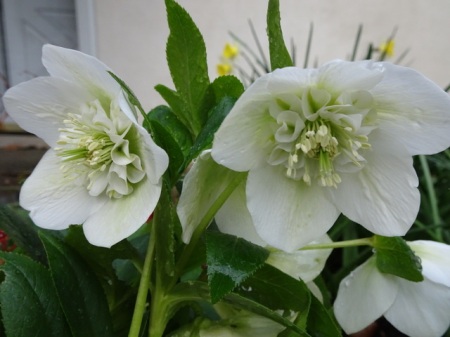 Hybrid hellebores, H. x hybridus, are my favorite hellebores because of their color range and variations in flower forms. Although the inside of the nodding flowers are often difficult to see without flipping them over, each flower is like a gift when I raise it into view. And the back of the flowers are often as pretty as the inside. The photo above shows a rare anemone form with an extra layer of ruffles around the center of the flower. It does not have a name and cannot be purchased. All the anemone form hellebores in our garden were discovered among the hundreds of single-flowered forms we sell each year.
Hybrid hellebores, H. x hybridus, are my favorite hellebores because of their color range and variations in flower forms. Although the inside of the nodding flowers are often difficult to see without flipping them over, each flower is like a gift when I raise it into view. And the back of the flowers are often as pretty as the inside. The photo above shows a rare anemone form with an extra layer of ruffles around the center of the flower. It does not have a name and cannot be purchased. All the anemone form hellebores in our garden were discovered among the hundreds of single-flowered forms we sell each year.
The photos in this post are of hellebores, one of the specialties of Carolyn’s Shade Gardens nursery. Hellebores bloom anytime from January to March, depending on the weather—some even start in the fall. They are easy to grow in well-drained soil in light conditions ranging from almost full sun to almost full shade. Their leaves are evergreen and deer resistant.
.
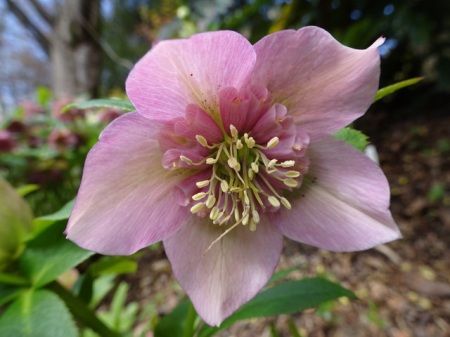 Another anemone form flower. If you want one for yourself, check all the flowers whenever you see hellebores for sale and you may find one. I found this among thousands of singles at one of our wholesale suppliers.
Another anemone form flower. If you want one for yourself, check all the flowers whenever you see hellebores for sale and you may find one. I found this among thousands of singles at one of our wholesale suppliers.
.
Hybrid hellebores or Lenten roses with nodding flowers and plainer green leaves come in a wide range of colors including the highly sought after black, yellow, and orange-tinged cultivars as well as fully double flowers. Many of the hybrid hellebores in our garden are unnamed or no longer available. If known, I am giving cultivar names as well as alternate cultivars that are similar in color and form.
Christmas rose types have desirable outward-facing flowers and often more interesting marbled leaves, but their color range is limited to white, pink, and red and the shades in between, and they do not come in doubles.
.
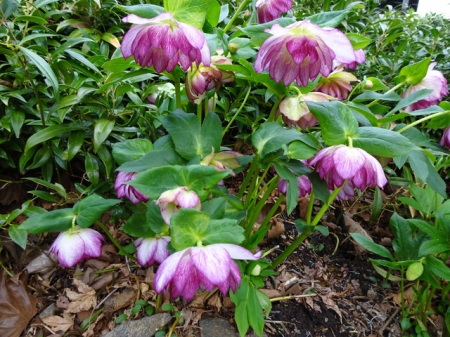 A double-flowered hybrid hellebore called ‘Peppermint Ice’ in the Winter Jewels Series.
A double-flowered hybrid hellebore called ‘Peppermint Ice’ in the Winter Jewels Series.
.
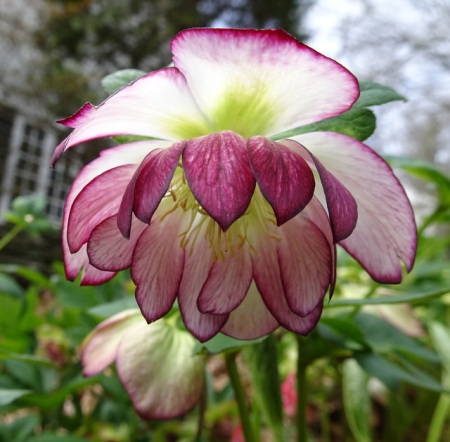 a close up of ‘Peppermint Ice’
a close up of ‘Peppermint Ice’
.
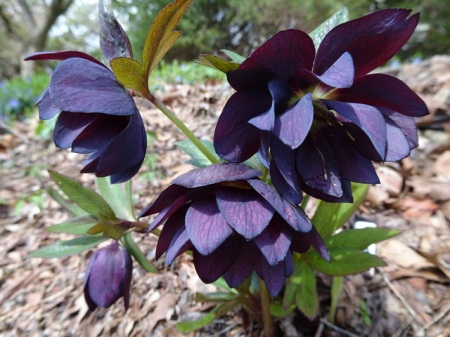 ‘Dark and Handsome’, a double-flowered hellebore in the Wedding Party Series. Dark-flowered hellebores are very striking in the garden but need to be carefully sited so they show up.
‘Dark and Handsome’, a double-flowered hellebore in the Wedding Party Series. Dark-flowered hellebores are very striking in the garden but need to be carefully sited so they show up.
.
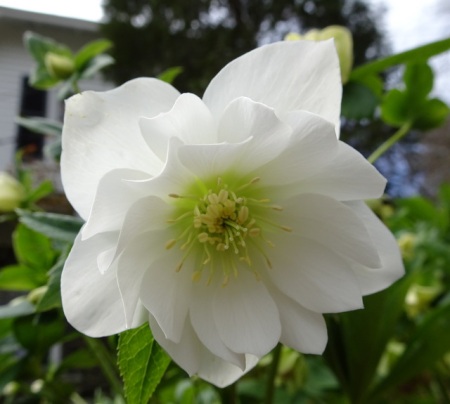 Light-colored hellebores, especially those with white flowers like double-flowered ‘Sparkling Diamond’ in the Winter Jewels Series, stand out in the landscape.
Light-colored hellebores, especially those with white flowers like double-flowered ‘Sparkling Diamond’ in the Winter Jewels Series, stand out in the landscape.
. When hybrid hellebores are happy, they produce dozens of flowers on very large plants. For optimal viewing, site them where you walk in the winter. This unnamed clump is on the hill above the stone wall along our drive, allowing us to look up into the flowers.
When hybrid hellebores are happy, they produce dozens of flowers on very large plants. For optimal viewing, site them where you walk in the winter. This unnamed clump is on the hill above the stone wall along our drive, allowing us to look up into the flowers.
. an old cultivar called ‘Single Black’
an old cultivar called ‘Single Black’
. ‘Cherry Blossom’ in the Winter Jewels Series sometimes has a dark ruffle around the center but can also be fully single or fully double.
‘Cherry Blossom’ in the Winter Jewels Series sometimes has a dark ruffle around the center but can also be fully single or fully double.
.
 ‘Cotton Candy’ in the Winter Jewels Series
‘Cotton Candy’ in the Winter Jewels Series
.
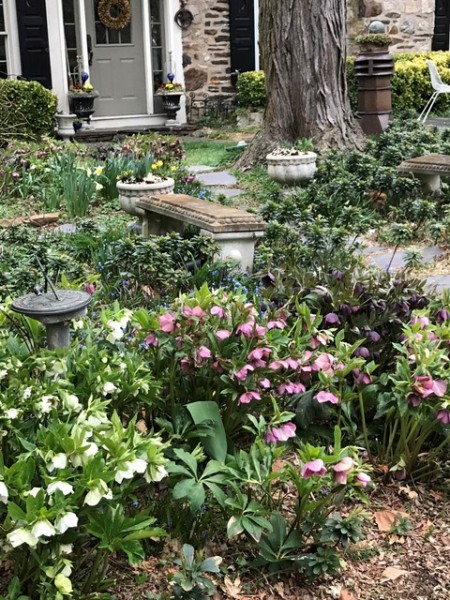 A customer sent me this photo of hybrid hellebores displayed beautifully in her garden (thanks, Mary).
A customer sent me this photo of hybrid hellebores displayed beautifully in her garden (thanks, Mary).
.
 ‘Glenda’s Gloss’ is a Christmas rose-type hellebore and a new addition to the FrostKiss Series. All hellebores in this series are upright with outward-facing flowers and gorgeous marbled leaves. They are the result of a complicated cross including Christmas rose, hybrid hellebores, and H. lividus.
‘Glenda’s Gloss’ is a Christmas rose-type hellebore and a new addition to the FrostKiss Series. All hellebores in this series are upright with outward-facing flowers and gorgeous marbled leaves. They are the result of a complicated cross including Christmas rose, hybrid hellebores, and H. lividus.
.
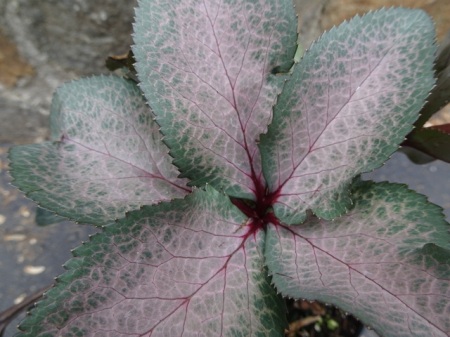 The new leaves of ‘Glenda’s Gloss’ are painted with pink and silver. The leaves of all FrostKiss hellebores gradually fade over the summer to bright green with gold marbling and remain ornamental all winter unlike hybrid hellebores, which can become unsightly.
The new leaves of ‘Glenda’s Gloss’ are painted with pink and silver. The leaves of all FrostKiss hellebores gradually fade over the summer to bright green with gold marbling and remain ornamental all winter unlike hybrid hellebores, which can become unsightly.
‘
 A customer photo of ‘Molly’s White’ purchased recently at Carolyn’s Shade Gardens. It is a very early-blooming member of the Frostkiss series and is almost identical to FrostKiss ‘Moondance’, which blooms a little later (thanks, Martin).
A customer photo of ‘Molly’s White’ purchased recently at Carolyn’s Shade Gardens. It is a very early-blooming member of the Frostkiss series and is almost identical to FrostKiss ‘Moondance’, which blooms a little later (thanks, Martin).
.
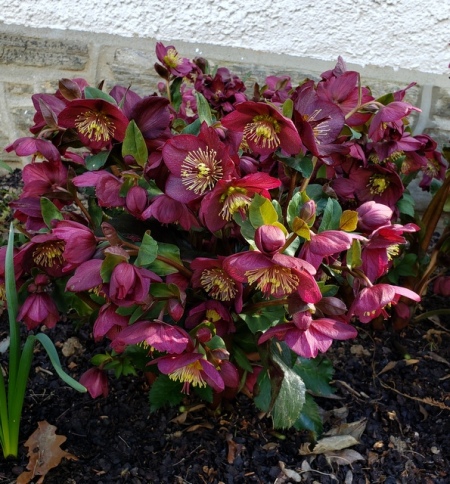 A customer photo of ‘Ice N’ Roses Red’ purchased at Carolyn’s Shade Gardens last spring. The Ice N’ Roses Series results from a complicated cross of Christmas rose and hybrid hellebores plus two other hellebore species, resulting in very robust plants with outward-facing flowers (thanks, John).
A customer photo of ‘Ice N’ Roses Red’ purchased at Carolyn’s Shade Gardens last spring. The Ice N’ Roses Series results from a complicated cross of Christmas rose and hybrid hellebores plus two other hellebore species, resulting in very robust plants with outward-facing flowers (thanks, John).
.
 ‘Shooting Star’ is another product of crosses between hellebore species, this time Christmas rose, Corsican hellebore, and H. lividus. Its delicate pink flowers fading to darker pink face outwards.
‘Shooting Star’ is another product of crosses between hellebore species, this time Christmas rose, Corsican hellebore, and H. lividus. Its delicate pink flowers fading to darker pink face outwards.
.
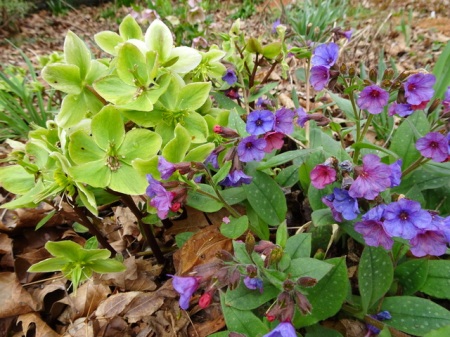 I love green-flowered hellebores. The photo shows pulmonaria with the faded flowers of ‘Honeyhill Joy’, the result of a cross between Christmas rose and Corsican hellebores. Christmas roses, H. niger, have outward-facing, pure white flowers and bloom very early in our garden. They are done now. Although Corsican hellebores, H. argutifolius, are hardy in our area, I don’t consider them a good garden plant as the flowers appear on the end of last year’s ratty leaf stalks.
I love green-flowered hellebores. The photo shows pulmonaria with the faded flowers of ‘Honeyhill Joy’, the result of a cross between Christmas rose and Corsican hellebores. Christmas roses, H. niger, have outward-facing, pure white flowers and bloom very early in our garden. They are done now. Although Corsican hellebores, H. argutifolius, are hardy in our area, I don’t consider them a good garden plant as the flowers appear on the end of last year’s ratty leaf stalks.
.
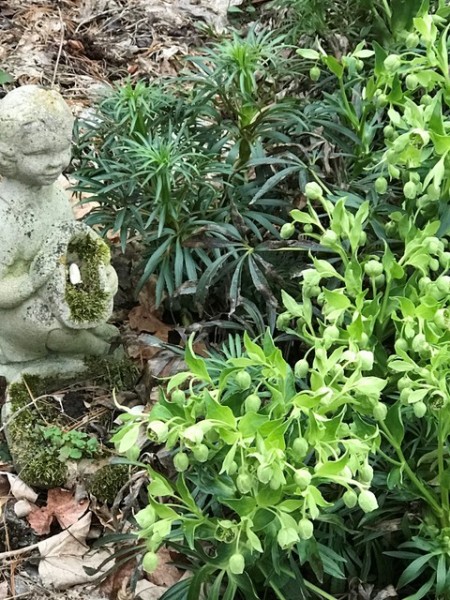 Another customer photo showing bearsfoot hellebore, H. foetidus, in her garden. I love this hellebore species with its clusters of bright chartreuse flowers topping the spidery dark evergreen leaves. The plants can be short-lived but usually reseed themselves before they disappear (thanks, Mary).
Another customer photo showing bearsfoot hellebore, H. foetidus, in her garden. I love this hellebore species with its clusters of bright chartreuse flowers topping the spidery dark evergreen leaves. The plants can be short-lived but usually reseed themselves before they disappear (thanks, Mary).
.
You can provide inspiration to me and other readers by posting comments about your own favorite hellebores. Blogs are a lot more fun for everyone, especially the writer, when they are interactive. Scroll down to the end of the page to the box where it says “Leave a Reply” and start typing—-it’s easy!
Carolyn
Notes: Every word that appears in orange on my blog is a link that you can click for more information. If you want to return to my blog’s homepage to access the sidebar information (catalogues, previous articles, etc.) or to subscribe to my blog, just click here.




